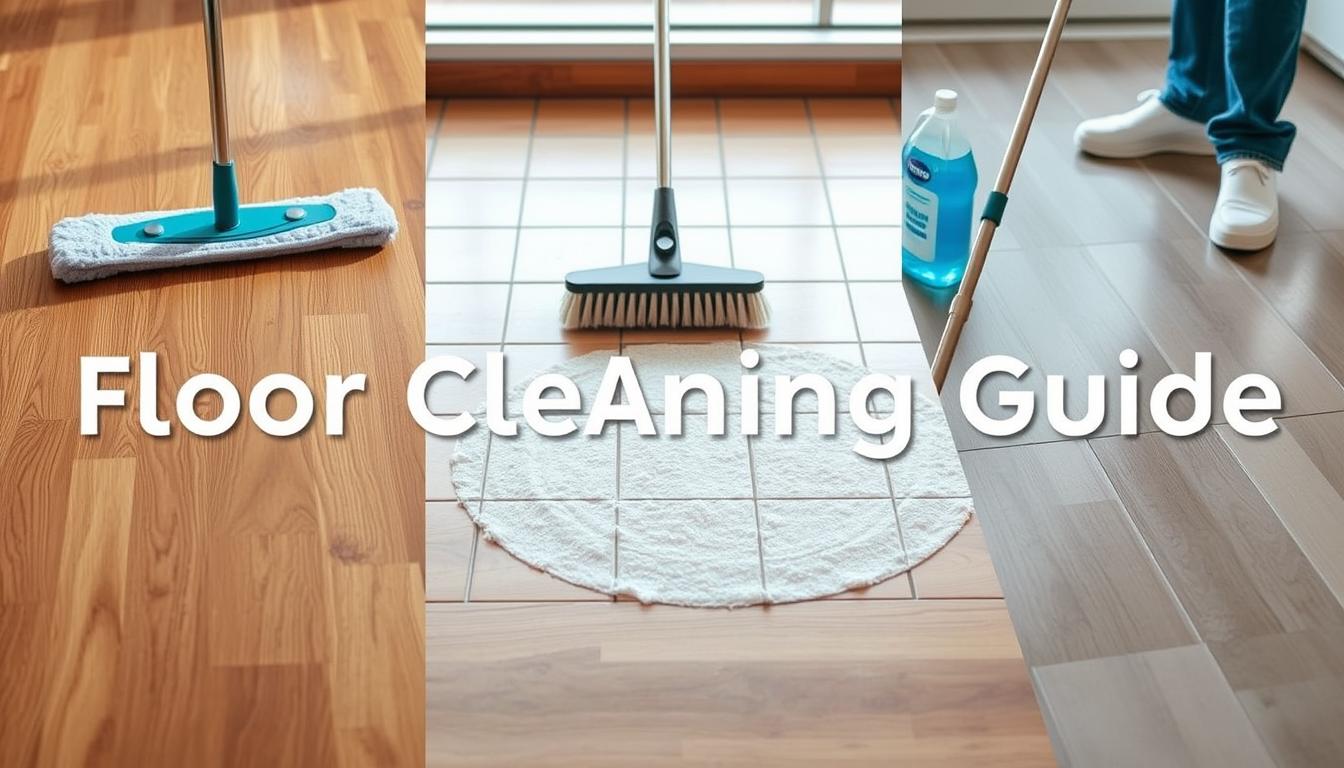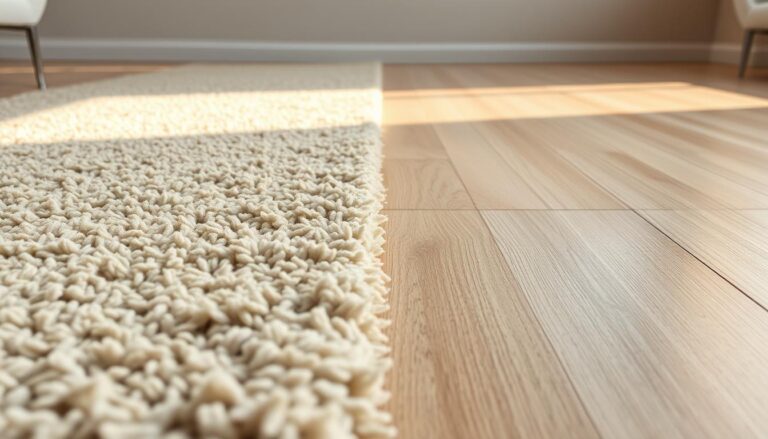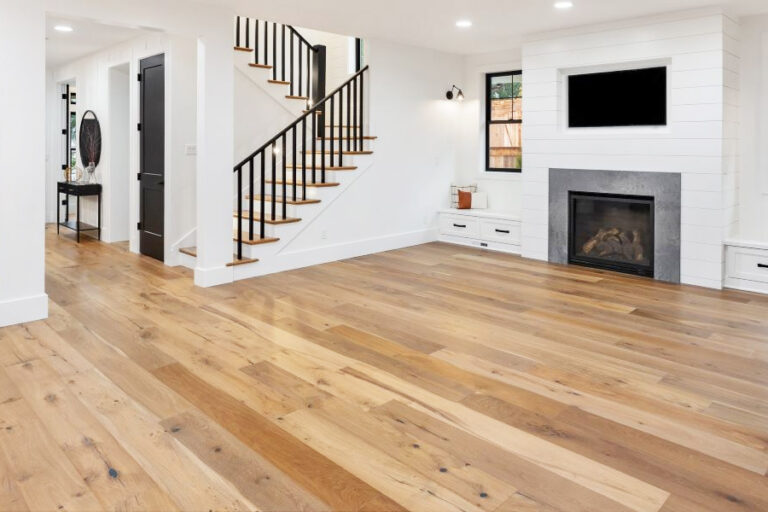The Ultimate Floor Cleaning Guide: Wood, Tile, Laminate & More
Keeping your home’s floors clean can be tough, with so many types of flooring. We get how hard it is to keep your wood, tile, laminate, and other floors looking good.
We aim to make floor cleaning easy and effective. In this guide, we’ll share the best ways to care for different floors. This way, you can keep your floors in top shape.
We’ll cover everything from hardwood’s delicate finish to tile’s toughness. You’ll learn key tips and tricks for floor care. Let’s explore the best ways to take care of your floors together.
Understanding Different Floor Types and Their Cleaning Needs
Cleaning your floors starts with knowing what they’re made of. Each type of flooring has its own needs to stay in good shape and look great.
Wood Flooring: Hardwood vs. Engineered Wood
Wood floors, whether they’re hardwood or engineered, need gentle care. Hardwood is solid, while engineered wood is layered. Both should be cleaned with a dry or damp mop. But, too much water can harm them.
Bona is a top choice for cleaning hardwood floors. It works well and is safe for many finishes.
Tile Floors: Ceramic, Porcelain, and Natural Stone
Tile floors, like ceramic, porcelain, and natural stone, can handle water better than wood. But, the grout between tiles needs extra care. It can stain and hold onto dirt. Clean the grout regularly and seal it to keep it looking good.
Laminate and Vinyl Flooring
Laminate and vinyl floors are cheaper than hardwood and tile. They’re easy to mop with a damp cloth. But, don’t use too much water, as it can warp laminate floors.
Carpet and Area Rugs
Carpet and area rugs need regular vacuuming to stay clean. For tough stains, try a carpet cleaner or a mix of white vinegar and water. Getting them professionally cleaned often can make them last longer.
Knowing your floor type is key to cleaning it right. Whether it’s hardwood, tile, laminate, vinyl, or carpet, pick the right cleaning tools and methods. This way, your floors will always look their best.
Essential Floor Cleaning Tools and Products
Effective floor cleaning starts with the basics. You need the right tools and products. This makes a big difference in keeping your floors looking good and lasting longer.
Basic Cleaning Equipment Every Home Needs
Every home needs basic cleaning tools. You should have a broom, dustpan, mop, and vacuum cleaner. These help with daily cleaning and quick messes. For deeper cleaning, a bucket and a floor scrubber are great.
Specialized Tools for Different Floor Types
Different floors need special cleaning tools. For example, hardwood floors do well with a microfiber mop. Tile floors might need a grout brush to clean between tiles. Using the right tool for your floor type cleans better and prevents damage.
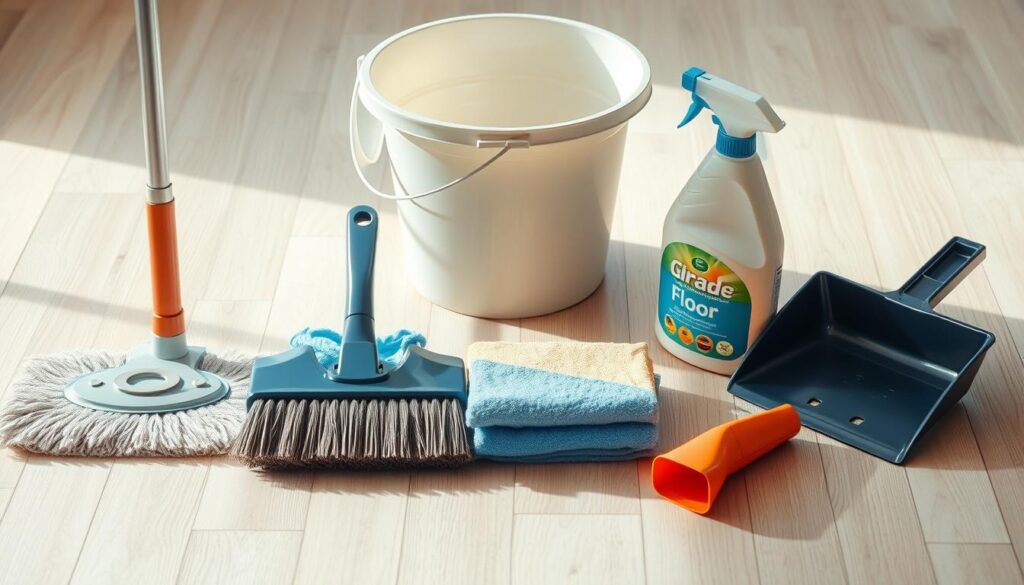
Eco-Friendly Cleaning Product Options
If you want to help the environment, try eco-friendly cleaning products. They’re made from natural ingredients and break down easily. Always check the labels to make sure they’re good for your floor.
How to Clean Floors: Step-by-Step Methods for Each Surface
Different floors need different cleaning methods to stay in top shape. We’ll show you how to clean various floors effectively. This way, you can keep your floors looking great.
Hardwood Floor Cleaning Technique
Hardwood floors bring warmth and style to any room. But, they need special care. Start by sweeping or vacuuming to get rid of dirt.
For sealed hardwood, mix a wood floor cleaner with water as the label says. If your wood is unsealed, use a dry mop or a cleaner made for unsealed wood.
Sealed vs. Unsealed Wood Considerations
Sealed hardwood can handle a bit of damp mopping. But, unsealed wood needs dry cleaning to avoid harm. Always follow the maker’s advice for your floor.
Preventing Water Damage
Too much water can harm hardwood floors. So, use a damp mop, not a wet one. Clean spills right away to stop water from getting into the wood.
Tile and Grout Cleaning Process
Tile floors are tough and versatile, but grout lines can get dirty. Start by sweeping or vacuuming to remove dirt. For ceramic and porcelain, a mild detergent and warm water work well.
For tough grout stains, try a grout cleaner or baking soda and water on the grout lines.
Dealing with Grout Lines
Grout lines can be hard to clean, but a grout brush and the right cleaner can help. For really tough stains, a grout steam cleaner might be needed.
Natural Stone Special Care
Natural stone tiles, like marble or granite, need extra care. Use a cleaner made for natural stone to avoid damage. Sealing natural stone regularly can also protect it from stains.
By following these cleaning steps, you can keep your floors looking their best. Regular care and the right products are essential for your floors’ beauty and durability.
DIY Floor Cleaning Solutions That Actually Work
Making your own floor cleaning solutions is easy and effective. You can use natural ingredients to create safe products for your family, pets, and the environment. This method reduces harsh chemicals and saves money on commercial products.
Homemade Wood Floor Cleaners
To clean wood floors, mix 1 cup of white vinegar with 1 gallon of warm water. Add a few drops of lemon essential oil for a nice smell. This solution is gentle and removes dirt and grime well. Always test a small area first to ensure the solution doesn’t damage the finish.
Natural Tile and Grout Cleaning Mixtures
To clean tile and grout, make a paste with baking soda and water. Apply it to the grout, wait 30 minutes, then scrub and rinse. For tough stains, mix equal parts baking soda and white vinegar. An expert says, “Baking soda and vinegar are great for cleaning grout without harsh chemicals.”
“The key to maintaining clean floors is regular maintenance and using the right cleaning products for your floor type.”
Using these DIY solutions keeps your floors clean and safe from harsh chemicals. Regular use of natural products helps keep your floors looking good and lasting longer.
Tackling Tough Floor Cleaning Challenges
Cleaning floors perfectly is not always easy. We often face tough stains and scratches that need extra care. Whether it’s a hard stain on your hardwood floor or a scratch on your tile, fixing these issues is vital. It helps keep your floors looking great and lasting longer.
Removing Stubborn Stains from Any Floor Type
Dealing with stubborn stains is a big challenge. For hardwood floors, try mixing baking soda with water. Put the paste on the stain, wait a few hours, then scrub and rinse it off. For tile floors, vinegar and water can work well on tough stains. Always test any cleaning solution on a small area first to avoid damage.
Dealing with Scratches and Scuffs
Scratches and scuffs are not just ugly; they can also cause more harm if not fixed. For small scratches on hardwood or laminate floors, a touch-up marker or scratch remover can help. For deeper scratches, you might need to sand and refinish the floor. On tile floors, scuffs can usually be removed with a soft scrubber and the right cleaner.
By facing these tough cleaning challenges, we can keep our floors in top shape. Regular care, along with the right cleaning methods and solutions, makes a big difference.
Floor Maintenance Schedule: Daily, Weekly, and Monthly Tasks
Having a good floor maintenance plan can make your floors last longer. By doing daily, weekly, and monthly tasks, you can keep your floors in great shape. This helps prevent damage and keeps them looking good.
Quick Daily Floor Maintenance Routines
Daily care is key for busy areas. Sweep or vacuum high-traffic spots every day to get rid of dirt and debris. This prevents scratches and damage.
For hardwood and laminate, use a dry mop or microfiber cloth to clean dust and dirt. Tile floors can be quickly mopped with a gentle cleaner to keep them looking nice.
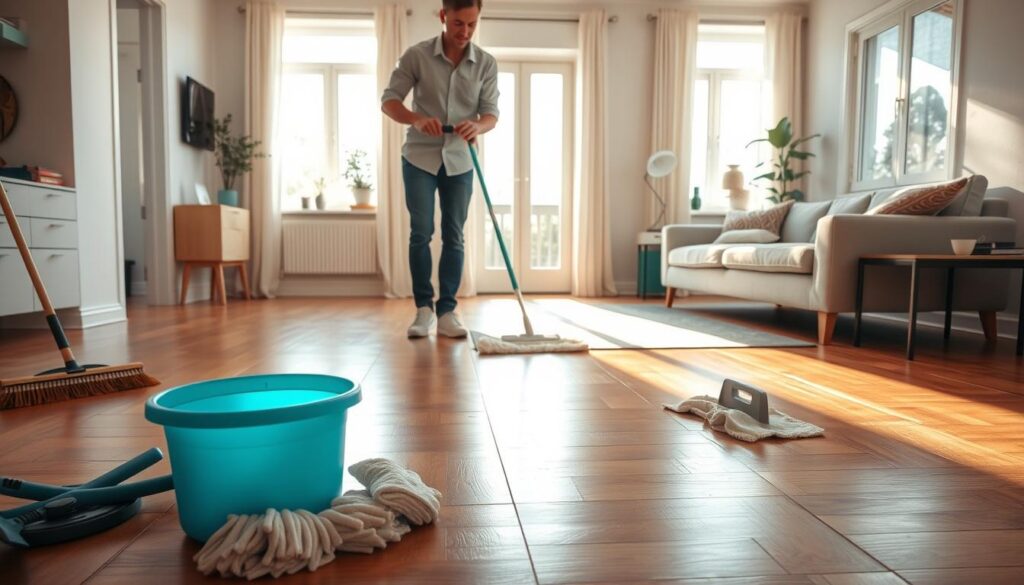
Weekly Deep Cleaning Recommendations
Weekly deep cleaning catches dirt and grime missed by daily cleaning. For hardwood floors, use a wood floor cleaner that fits your floor’s needs. Tile and grout need a deeper clean with a grout cleaner to remove tough stains.
Steam cleaning is a good option for a deep clean without harsh chemicals.
Monthly and Seasonal Floor Care
Monthly, check your floors for scratches or damage and fix them right away. Seasonally, do tasks like re-waxing or re-sealing floors to protect them. Hardwood floors might need refinishing every few years to keep them looking good.
Keeping Your Floors Beautiful for Years to Come
Proper floor care is an investment in the long-term beauty and durability of your floors. By following the cleaning and maintenance tips outlined in this guide, we can ensure our floors remain a stunning feature of our homes for years to come.
Regular sweeping, mopping, and deep cleaning will help prevent dirt and grime from building up and causing damage. Using the right cleaning products for our specific floor type is also key. For example, using a hardwood floor cleaner on engineered wood floors will help maintain their finish and integrity.
By incorporating a floor maintenance schedule into our daily routine, we can enjoy the benefits of beautiful, well-maintained floors. Whether we have wood, tile, laminate, or carpeted floors, a little regular care will go a long way in preserving their appearance and extending their lifespan.

